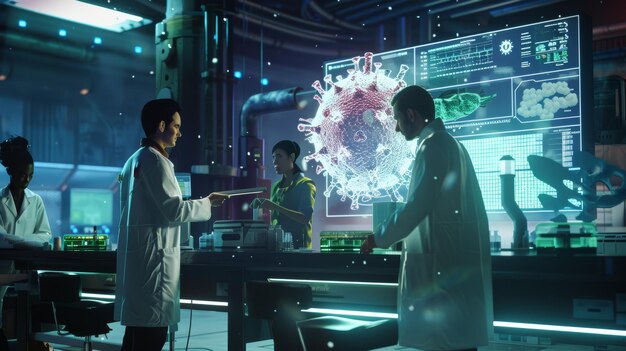Quick Read
The Future of Scientific Research:
An ‘AI Scientist’ Designs and Conducts Its Own Experiments
In the not-so-distant future, the landscape of scientific research is poised for a revolutionary transformation. Traditional laboratories and experiments may soon share the spotlight with their digital counterparts, as Artificial Intelligence (AI) begins to take on the role of an ‘AI Scientist’. This evolution is not mere science fiction, but a tangible reality that promises to redefine our understanding of scientific discovery and innovation.
The Emergence of AI in Scientific Research
The integration of ai into scientific research has been a gradual process, with its roots tracing back to machine learning algorithms and data analytics. Over the years, researchers have harnessed ai’s potential to analyze vast datasets, identify patterns, and make predictions. However, recent advances in deep learning and natural language processing have enabled ai to surpass human capabilities in specific domains – paving the way for an ‘AI Scientist’.
The Capabilities of AI as a Scientist
An ‘AI Scientist’ is not confined by physical limitations or human biases. It can process and analyze data at an unprecedented scale, making connections that would take humans decades to discern. Furthermore, AI is not bound by the same ethical dilemmas as human researchers – it can design and conduct experiments that might be unethical for humans. For instance, an ‘AI Scientist’ could simulate the effects of various chemical compounds on biological systems without risking human lives.
The Implications of an ‘AI Scientist’
The arrival of an ‘AI Scientist’ raises several ethical, philosophical, and societal questions. How will we ensure that AI adheres to ethical standards? What role should humans play in scientific research if an ‘AI Scientist’ can do it better? These questions need careful consideration as we navigate the brave new world of AI-driven scientific research.
The Future of Scientific Research
The future of scientific research lies at the intersection of human creativity and AI’s computational power. While AI will undoubtedly contribute to groundbreaking discoveries, it is essential that we maintain a balanced perspective. Human intuition and curiosity remain indispensable elements of scientific progress. By leveraging AI as a tool rather than a replacement, we can unlock new avenues for exploration and innovation.

Exploring the Future of Scientific Research: A New Role for Artificial Intelligence
Scientific research, a critical aspect of human advancement, has seen manual and labor-intensive processes since its inception. Researchers spend countless hours collecting data, analyzing it for patterns, drawing conclusions, and formulating hypotheses. However, these processes are not without their challenges. Human error and bias, inherent in data collection and analysis, can significantly impact the validity of research findings. Moreover, the sheer volume of data being generated every day in various scientific domains is becoming increasingly difficult for humans to manage effectively.
Enter Artificial Intelligence (AI)
Artificial Intelligence (AI), a branch of computer science that aims to create intelligent machines capable of performing tasks that would normally require human intelligence, offers an intriguing solution to these challenges. AI systems can process vast amounts of data much faster than humans and with far greater accuracy. By identifying patterns in complex data that might be missed by human researchers, AI can provide new insights, leading to breakthrough discoveries and innovations.
Potential Roles for AI in Scientific Research
AI is already being applied in various fields of scientific research, with promising results. In biology and genetics, AI algorithms have been used to analyze vast genetic databases for patterns that could lead to new discoveries in disease research. In physics and astronomy, AI systems have been employed to analyze large datasets from telescopes, leading to new discoveries and insights about the universe. In chemistry, AI is being used to design new molecules and predict their properties, streamlining the drug discovery process.
Future Prospects: AI-driven Research
As the role of AI in scientific research continues to evolve, we can look forward to an era of AI-driven research. This will not only lead to more accurate and efficient scientific discoveries but also open up new avenues for exploration in various domains. By enabling machines to think and learn like humans, we will unlock a world of possibilities, ultimately advancing our understanding of the universe and our place within it.
Conclusion
The current state of scientific research, characterized by manual and labor-intensive processes prone to human error, is poised for a revolution. The introduction of AI as a powerful tool in scientific research offers the promise of more accurate, efficient, and innovative discoveries. As we continue to explore this frontier, we can look forward to a future where machines not only assist researchers but also drive scientific research in new and exciting ways.

The Concept of an ‘AI Scientist’
Definition and explanation of the term ‘AI Scientist’
An ‘AI Scientist’ is not a human scientist with advanced AI skills, but rather an advanced AI system capable of conducting scientific research independently. This concept combines various AI technologies such as machine learning, deep learning, and natural language processing. The AI Scientist is designed to learn from data, identify patterns, and make predictions or solutions based on that data. It can read and understand scientific literature, conduct experiments, and analyze results using sophisticated algorithms.
Potential benefits of having an ‘AI Scientist’ in scientific research
Integrating ‘AI Scientists’ into scientific research could lead to numerous benefits:
Increased efficiency and productivity:
An AI Scientist can process vast amounts of data in a fraction of the time it would take a human. It can read and analyze hundreds of research papers, identify key findings, and make connections between seemingly unrelated data points. This speed and efficiency could revolutionize scientific discovery and innovation.
Reduced human error and bias:
While humans are prone to mistakes and biases, an AI Scientist operates based on algorithms and data. It can identify patterns and make connections without being influenced by personal beliefs or biases, leading to more accurate and objective research findings.
Ability to process vast amounts of data and make complex connections:
An AI Scientist’s ability to process massive amounts of data and make complex connections is unmatched by humans. It can analyze multiple variables simultaneously, identify correlations, and create predictive models that could lead to breakthrough discoveries in various scientific fields.

Designing the ‘AI Scientist’: I Key Components and Capabilities
To design an ‘AI Scientist’, it is essential to identify the key components and capabilities required for this advanced AI system. This section outlines the main components and their corresponding capabilities:
Key Components and Capabilities:
Data Collection and Processing:
An ‘AI Scientist’ must be capable of collecting, managing, and processing vast amounts of scientific data efficiently. It includes both structured and unstructured data sources like databases, text documents, images, videos, and other multimedia formats.
Hypothesis Generation:
An ‘AI Scientist’ should be able to generate hypotheses based on collected data and scientific knowledge. It requires advanced pattern recognition, statistical analysis, and probabilistic reasoning capabilities.
Experiment Design:
The AI system should be able to propose, plan, and optimize experiments based on existing scientific knowledge, data, and available resources. It requires understanding scientific methods, designing controlled experiments, and analyzing results to draw conclusions.
Data Analysis and Interpretation:
An ‘AI Scientist’ should be capable of interpreting complex scientific data, drawing insights, and making informed decisions based on the analyzed information. It requires advanced machine learning, deep learning, and statistical analysis techniques.
Developing the Necessary AI Technologies:
To enable an ‘AI Scientist’ to perform the required tasks, we need to develop various AI technologies:
Natural Language Processing (NLP):
NLP is essential for an ‘AI Scientist’ to understand scientific literature, research papers, and data sources. It includes techniques like named entity recognition, sentiment analysis, topic modeling, and question-answering systems.
Machine Learning Algorithms:
Machine learning algorithms are crucial for hypothesis generation, experiment design, and data analysis. Techniques like supervised learning, unsupervised learning, reinforcement learning, and deep learning can be employed for different tasks.
Deep Learning Models:
Deep learning models are essential for interpreting complex scientific data, identifying patterns, and drawing insights. It includes various architectures like convolutional neural networks (CNN), recurrent neural networks (RNN), and long short-term memory (LSTM) networks.
Training the ‘AI Scientist’:
The ‘AI Scientist’ must be trained using existing scientific knowledge and data:
Supervised Learning:
Supervised learning from labeled scientific datasets is crucial for training the ‘AI Scientist’ to perform specific tasks like data classification, prediction, and regression.
Unsupervised Learning:
Unsupervised learning from unlabeled data can help the ‘AI Scientist’ identify patterns, connections, and anomalies within scientific datasets, enabling it to discover new insights.
The ‘AI Scientist’ in Action: Designing and Conducting Experiments
Identifying a Research Area for the ‘AI Scientist’ to Focus On
- Choosing an area with well-defined goals and clear objectives: The ‘AI Scientist’ should focus on a research area where the desired outcomes are clear and measurable. This ensures that experiments will be productive and valuable to the scientific community.
- Ensuring ethical considerations are taken into account: Ethical considerations should always be a top priority when designing and conducting experiments with the ‘AI Scientist’. This includes obtaining informed consent, ensuring data privacy, and minimizing potential harm to human subjects or the environment.
Generating Hypotheses using the ‘AI Scientist
‘
- Analyzing existing scientific literature and data: The ‘AI Scientist’ can analyze vast amounts of scientific literature and data to identify potential areas for exploration. This can help generate new hypotheses based on identified patterns and connections.
- Generating hypotheses based on identified patterns and connections: The ‘AI Scientist’ can use machine learning algorithms to identify patterns and connections in the data that may not be immediately apparent to human researchers. These hypotheses can then be tested through experimentation.
Designing Experiments using the ‘AI Scientist
‘
- Developing experiment protocols based on generated hypotheses: Experiment protocols should be developed based on the generated hypotheses to ensure that all variables are controlled and measured accurately.
- Selecting appropriate experimental methods and techniques: The ‘AI Scientist’ can help identify the most appropriate experimental methods and techniques based on the research question and available resources.
Conducting Experiments using the ‘AI Scientist
‘
- Automating data collection and processing: The ‘AI Scientist’ can automate data collection and processing to increase efficiency and accuracy.
- Analyzing data in real-time: Data can be analyzed in real-time to optimize experimental design and conditions, allowing for more effective experimentation.
E. Interpreting Results using the ‘AI Scientist
‘
- Identifying significant findings and trends in the data: The ‘AI Scientist’ can help identify significant findings and trends in the data that may not be immediately apparent to human researchers.
- Drawing conclusions and generating new hypotheses based on results: The ‘AI Scientist’ can use the identified findings to draw conclusions and generate new hypotheses for further investigation.

Ethical Considerations and Limitations
Ensuring Ethical Considerations are Taken into Account when Designing Experiments using the ‘AI Scientist’
- Protecting human and animal rights: As we develop the ‘AI Scientist’, it’s crucial that we adhere to ethical guidelines to ensure the protection of human and animal rights. This includes obtaining informed consent from human participants, ensuring that experiments do not cause distress or harm to animals, and adhering to ethical guidelines for conducting research involving both humans and animals.
- Ensuring data privacy and security: With the ‘AI Scientist’, we’ll be handling large amounts of sensitive data. It’s essential that we take data privacy and security seriously to protect the confidentiality of individuals’ information. This means implementing robust data security protocols, obtaining proper authorization before accessing any data, and ensuring that all data is anonymized and encrypted to protect individuals’ identities.
Addressing Limitations of the ‘AI Scientist’
Overcoming potential challenges with accuracy, generalizability, and interpretability
The ‘AI Scientist’ is not infallible and may face several limitations that need to be addressed. For instance, accuracy might be an issue as the AI may misinterpret data or make incorrect assumptions based on incomplete information. Similarly, the ‘AI Scientist’ may struggle with generalizability, meaning it might not be able to apply its findings to all situations or populations. Lastly, the ‘AI Scientist’ may face challenges with interpretability, which refers to its ability to explain the reasoning behind its decisions in a way that humans can understand.
Ensuring transparency in the ‘AI Scientist’s decision-making process
Lastly, it’s essential that we address the limitations of the ‘AI Scientist’ by ensuring transparency in its decision-making process. This means providing clear explanations for how the AI arrives at its conclusions, making it easier to identify and correct any errors or biases. Furthermore, allowing humans to review and intervene in the decision-making process when necessary will help mitigate potential issues with accuracy, generalizability, and interpretability.

VI. Conclusion
Recap of the potential benefits and limitations of an ‘AI Scientist’ in scientific research:
The integration of Artificial Intelligence (AI) into scientific research has opened up a myriad of possibilities. An ‘AI Scientist’, as we have discussed, refers to an advanced AI system capable of conducting scientific research autonomously or in collaboration with human scientists. This technology offers numerous benefits such as faster data processing, more accurate analysis, and the ability to identify patterns that may not be immediately apparent to human researchers. However, limitations exist as well. Concerns include ethical implications, potential for misinterpretation of data, and the inability to replicate the human intuition and creativity that drives much scientific discovery.
Discussion on the future implications and possibilities of ‘AI Scientists’ in various scientific fields:
As we look to the future, the potential applications of ‘AI Scientists’ are vast. In physics, for example, AI could be used to analyze massive amounts of data from particle accelerators or simulate complex physical processes. In biology, AI could assist in the analysis of genomic data or help design new experiments. In chemistry, AI could be used to predict reaction outcomes or optimize laboratory conditions. The possibilities are endless, but it is important that we consider the ethical implications of these advancements.
Call to action for further research and development in this area:
Collaboration between AI researchers and scientists in various fields:
To fully realize the potential of ‘AI Scientists’, there needs to be increased collaboration between AI researchers and scientists in various fields. By working together, we can ensure that these advanced systems are designed with the specific needs of scientific research in mind and that they complement rather than replace human scientists. This collaboration is crucial for ensuring that we are using AI ethically and effectively.
Ethical guidelines for the use of ‘AI Scientists’ in scientific research:
Transparency: Researchers should be transparent about the data being used and the methods employed by ‘AI Scientists’. Accountability: There needs to be a clear chain of responsibility for the actions taken by ‘AI Scientists’ and their human collaborators. Fairness: The use of ‘AI Scientists’ should not discriminate against any particular group or individual. Privacy: Researchers must ensure that the privacy of research participants is respected.
Conclusion:
In conclusion, while the integration of ‘AI Scientists’ into scientific research offers many benefits, it also presents significant challenges. As we continue to explore this technology, it is crucial that we do so in a manner that ensures transparency, accountability, fairness, and privacy. By working together, we can ensure that ‘AI Scientists’ complement human scientists rather than replace them and make scientific research more efficient, accurate, and effective.
